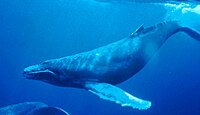
Photo from wikipedia
Humpback whales (Megaptera novaeangliae) require a suite of essential habitats during their long migration. Therefore, the identification of critical habitats is important for continuation of their successful recovery. In this… Click to show full abstract
Humpback whales (Megaptera novaeangliae) require a suite of essential habitats during their long migration. Therefore, the identification of critical habitats is important for continuation of their successful recovery. In this study we investigated the behaviours and habitat usage exhibited by humpback whales in two known aggregation sites on the east coast of Australia. Using a combined 5400 humpback whale records collected from Hervey Bay between 1999 and 2009 and from the Gold Coast Bay between 2011 and 2018, we analysed different types of behavioural categories. We found that humpback whales in Hervey Bay primarily exhibited surface travel and non-aggressive social behaviour, whereas both sites appeared to be similarly important for resting. Our results suggest that the Gold Coast Bay provides habitat for a wide range of critical humpback whale activities, in particular for resting mother–calf pairs, mature males seeking copulation and socialising immature whales. Hervey Bay had a higher number of mother–calf pair sightings, confirming the area as an important resting site. This study demonstrates that the two regions are critical habitats for humpback whales during their annual migration, but for different essential activities, and should be considered as a whale protection area.
Journal Title: Marine and Freshwater Research
Year Published: 2021
Link to full text (if available)
Share on Social Media: Sign Up to like & get
recommendations!